With attractive flowers, heady scent, glossy leaves and unusual fruit, it is perhaps surprising that the wild gardenia is not more commonly used as a garden staple. It also makes a good container plant and it does well as a flowering bonsai plant.

The wild gardenia (Gardenia thunbergia), also known as the forest, starry or white gardenia, flowers in the months of summer, when the plant carries its creamy blooms in various stages of maturity.
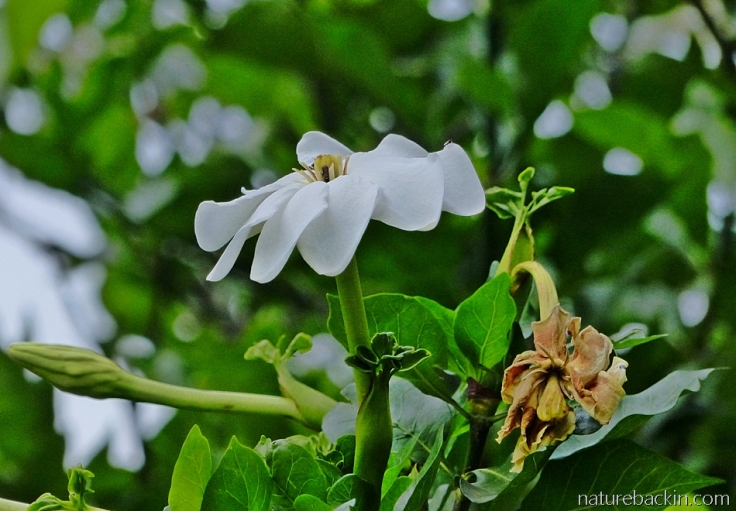
In the wild it is a forest plant, growing in or on the margins of coastal and inland forests in the eastern regions of southern Africa, from the Eastern Cape and north into Mozambique. It is a slow-growing plant that thrives in sun or dappled shade, eventually reaching a height of 5–7 metres.
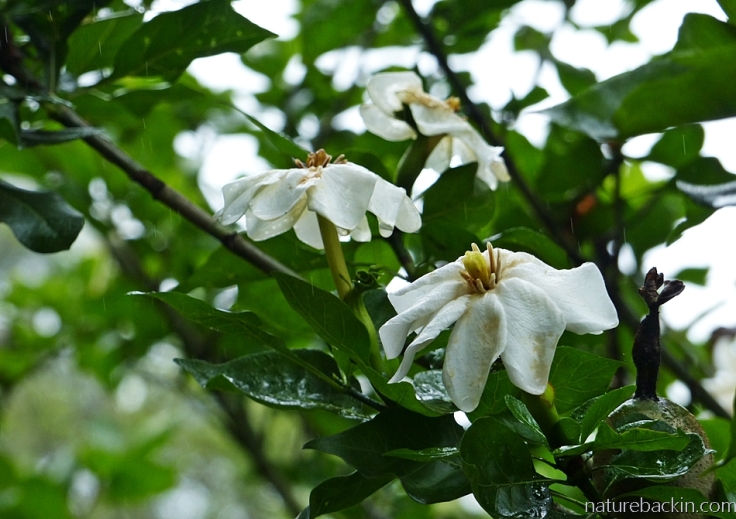
I like how the plant with its dense foliage brings a foresty feeling to the garden. The scent of the flowers, especially at night, is exquisite and the flowers attract night-flying moths.
The genus Gardenia comprises about 60 species that occur in tropical and warmer parts of Africa, Asia and Europe. Of these, 6 species including Gardenia thunbergia are found in South Africa (but not in the Northern and Western Cape regions).
Gardenia thunbergia was one of the first South African gardenias collected by European botanists and it was introduced into the Royal Botanic Gardens at Kew in London as far back as 1773. Currently, it is still grown in the Palm House at Kew.
Several of the gardenia species, including Gardenia thunbergia, carry the isiZulu name umvalasangweni, which literally means the back-gate closer as gardenias were traditionally planted at homestead gates as a protection against evil spirits and gardenias were used to close cattle kraals.
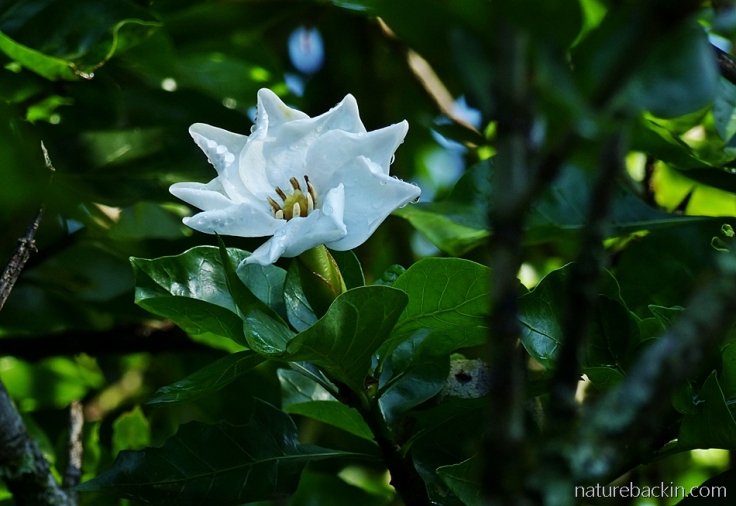
The genus name Gardenia honours the appropriately named Dr Alexander Garden (1730–1791), a Scottish medical practitioner who settled in South Carolina in North America in 1752. He was a keen naturalist (botany and zoology) and collector, sending specimens to Linnaeus and other scientists in Europe (see more on Garden here).
The species part of the name, thunbergia, is named after the Swedish physician and botanist, Carl Pehr (Peter) Thunberg (1743–1828). He was a pupil of Carl Linnaeus at the University of Uppsala. His subsequent scientific work and collecting in South Africa and later in Japan led to him being called the “father of South African botany” and the “Japanese Linnaeus”. His many publications included comprehensive works on the flora of South Africa and of Japan. For more information on Thunberg see here.
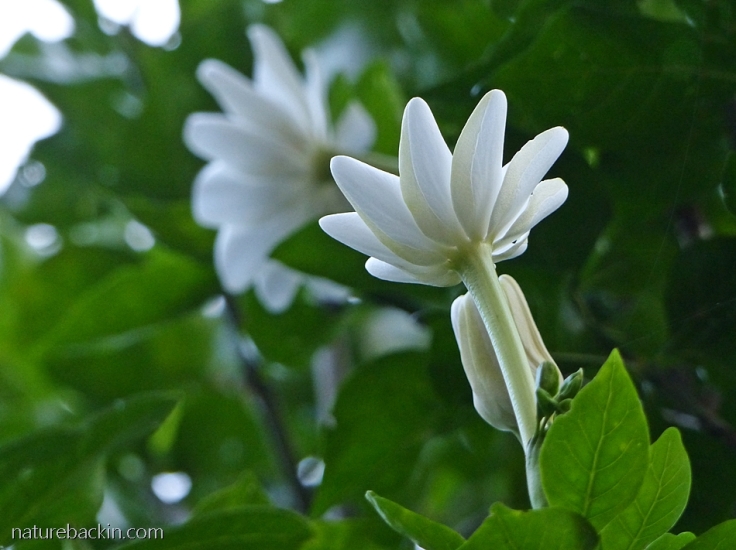
The photo above shows how the petals are joined to a long tube, which is about 7 cm long. As the nectar is at the bottom of the tube, only large moths, such as hawk moths, which have a long proboscis, can reach down the long tube of the flower to reach the nectar.
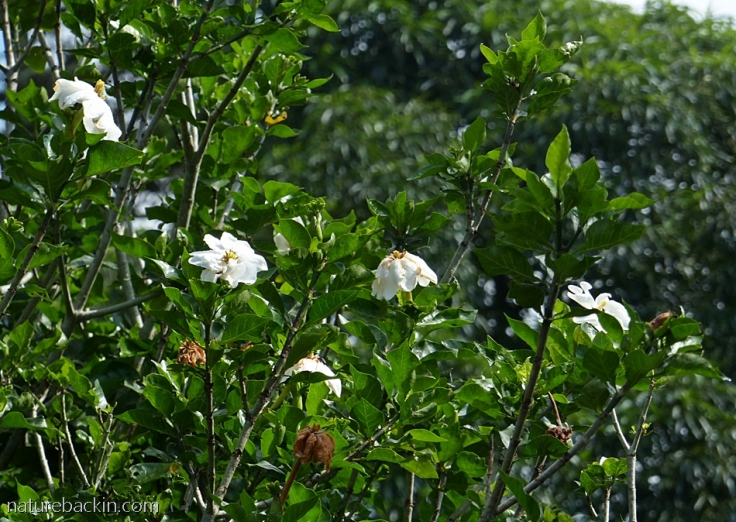
The wild gardenia has rather stiff upright stems and it makes a good hedging plant. It is a prolific flowerer in the summer.

Gardenias are members of the Rubiaceae family (coffee family). In species in this family flowers are bisexual or unisexual. I think that the flower of the wild gardenia in the photo above is a male flower, as only the 8 pollen-producing anthers are present.
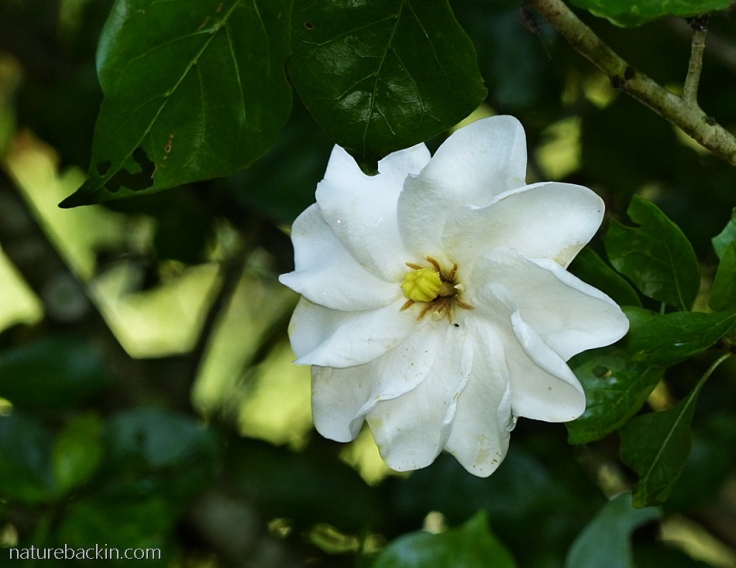
In this flower the stigma where the pollen germinates is visible in the centre of the flower, surrounded by the 8 anthers. Finding out a bit more about flower anatomy so as to better understand this wild gardenia flower, I read that the female part of the flower, the pistil, comprises the ovary in the swollen base of the flower, from which emerges the long style topped by the stigma (https://treesa.org/gardenia-thunbergia/). Any feedback from anyone who is better versed in flower anatomy than I am is very welcome.
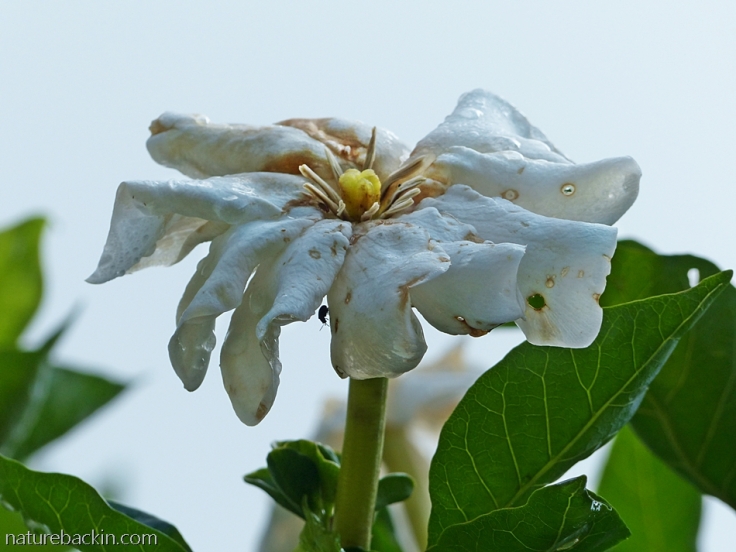
As the flower ages the petals start to droop and turn beige in colour as they start to dry. The scent is still strong even as the flowers age.

This flower is almost completely shrivelled. As this is a female flower it will develop a fruit at its base. The fruits of the wild gardenia grow to be larger than a chicken egg and they are hard and woody.
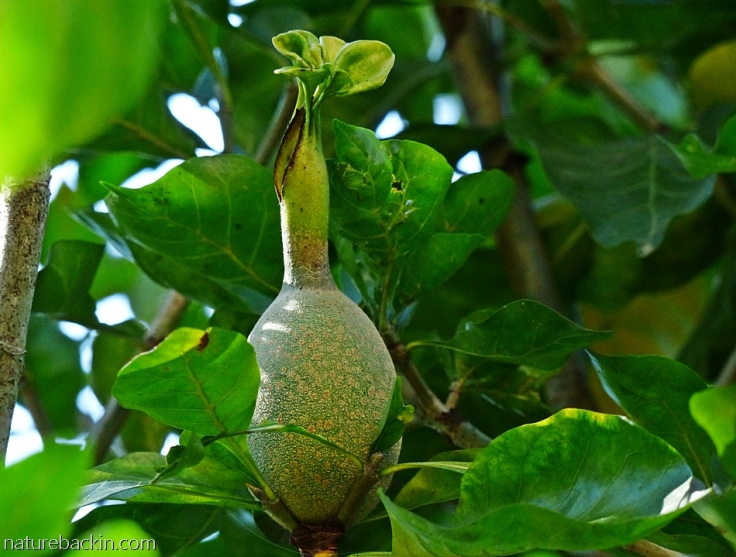
The fruit swells from what was the base of the flower. Younger fruit is greenish with raised dots, but as it matures the skin becomes grey and very hard and woody.
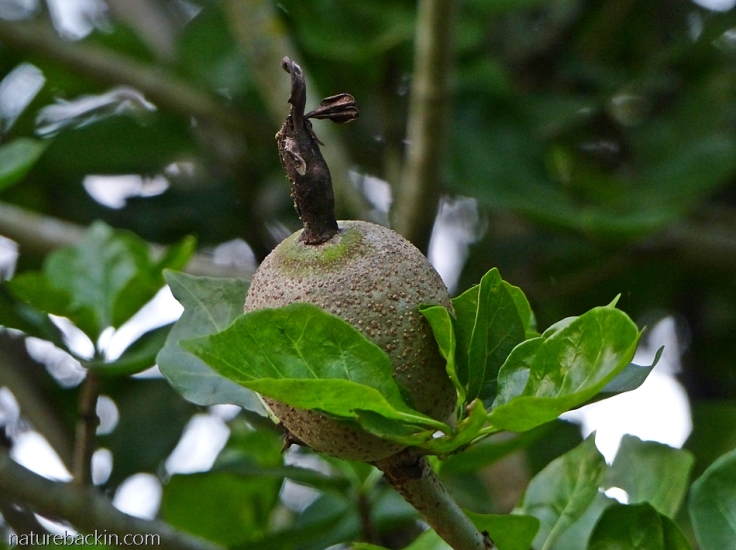
A mature fruit of the wild gardenia, showing its rough grey skin covering with raised dots. In addition to being hard the fruits are very fibrous. The fruits do not self-seed and can remain on the bush for years without splitting. Propagation depends on the fruit being eaten by large herbivores such as elephants, large antelope and buffalo. Such animals eating the fruits act as seed dispersers.
In the absence of any assistance from large herbivores, gardeners and botanists have to work hard to harvest the seeds. The entry on Gardenia thunbergia on the SANBI website notes that secateurs are blunted in the process of cutting off the fruits, and that heavy blunt instruments such as hammers are required to break the fruits open. Most laboriously, nails or heavy-duty spoons are required to scrape and scoop out the seeds.
In addition to seeds, plants can also be propagated from cuttings and truncheons.
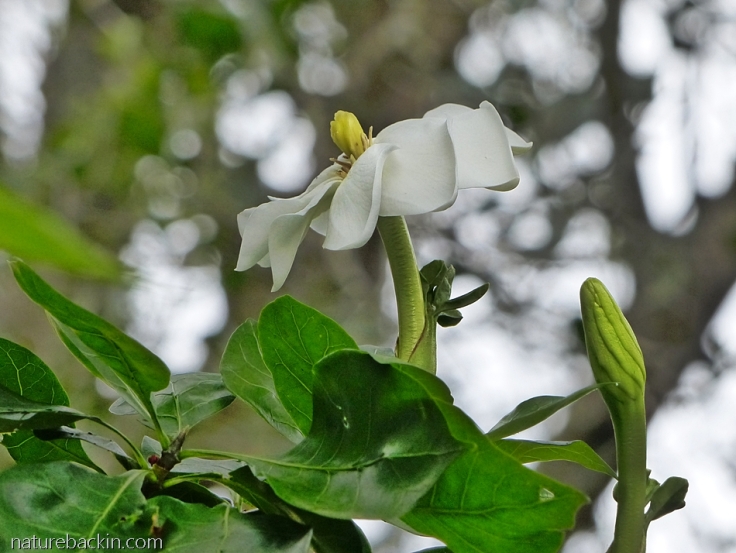
In traditional medicine parts of the plants including the roots and the leaves have been used for gastric complaints and skin diseases, for skin lesions resulting from leprosy and in the treatment of syphilis.
Being slow growing, the wood of the wild gardenia is dense and hard. The wood is a yellowish colour and takes well to polishing. Interestingly the wood can be bent without breaking. Because the size of the wood is limited, it has been used to make smaller items such as buttons, tools, clubs, yokes, axles and implement handles.
It is a dependable and easy plant to have in the garden. It retains its shape without needing pruning and it does not normally require watering, but drought conditions will test it. It prefers warmer climates and it is well suited to our part of the country.
Sources:
Boon, Richard. 2010 (2nd ed.). Pooley’s Trees of Eastern South Africa. Durban: Flora & Fauna; Encylopedia.com. 2020. Alexander Garden. https://www.encyclopedia.com/people/science-and-technology/biology-biographies/alexander-garden; Notten, Alice. 2003. Gardenia thunbergia. PlantZAfrica. South African National Biodiversity Institute (SANBI). http://pza.sanbi.org/gardenia-thunbergia; Plug. C. (compiler). 2014. Thunberg, Dr Carl Pehr. S2A3 Biographical Database of Southern African Science. https://www.s2a3.org.za/bio/Biograph_final.php?serial=2843; Trees SA. 2020. Gardenia thunbergia. https://treesa.org/gardenia-thunbergia/
Posted by Carol









January 30, 2020 at 3:23 am
Fabulous! I can smell the fragrance…. xxx
LikeLiked by 1 person
January 30, 2020 at 8:12 pm
The fragrance is quite overwhelming currently!
LikeLiked by 1 person
January 19, 2020 at 6:22 am
While I have always enjoyed the refinement, beauty, and fragrance of the gardenia flower and its petals, I’m more fascinated by the wild gardenia anatomy in the life cycle you described in your narrative and illustrated with your photographs. I like the wild toughness of its parts!
LikeLiked by 1 person
January 20, 2020 at 7:47 pm
It is a curious mix of refinement and toughness.
LikeLiked by 1 person
January 19, 2020 at 3:10 am
Thanks for that info….I’ve never tried a gardenia as a houseplant before, as they have a reputation for being “difficult”. It must be wonderful to see them growing wild. A question: do you have many types of orchids? I’ve become interested in them, as they are easy wehouseplants, especially since they bloom all Summer if put outside. Alas…thoughts of warm weather as I am watching the snow fall outside right now!⛄❄
LikeLiked by 1 person
January 20, 2020 at 7:46 pm
I gather that there are more than 450 wild orchid species in South Africa, with many of these being terrestrial orchids (and not well suited to pots). However, some especially the epiphytes can be grown indoors. For a flavour of some SA orchids see http://pza.sanbi.org/plants/search/advanced?pow_page=family&name=Orchidaceae
Snow is hard to imagine from here! I hope you are warm indoors, and at least you do have the prospect of spring on the horizon.
LikeLiked by 1 person
January 18, 2020 at 5:20 am
Such a beautiful plant and flower. You certainly dove into learning all about it. I’ve seen specimens in people’s yards here and there in my travels, but I believe most of them have pink flowers. I imagine they are likely part of the same family.
LikeLiked by 1 person
January 20, 2020 at 7:35 pm
I am not familiar with pink gardenias, only with the rather similar camellias (many of which are pink), but its likely somebody would have developed pink gardenias by now!
LikeLike
January 21, 2020 at 12:36 am
To be honest, I have trouble telling the two apart. They’re beautiful flowers, but in our climate they tend to turn brown whenever it rains and it rains often during the time they are blooming. Thus they’ve never been a particular favorite of mine here. It’s likely the pink ones I imagined actually were camellias. 😀
LikeLiked by 1 person
January 18, 2020 at 2:56 am
Interesting post. I’ll have to be on the lookout for them around here. For some reason, it’s not a plant I immediately think of as flowering in places I frequent. Probably more to do with my powers of observation than the distribution of the plant.
LikeLiked by 1 person
January 20, 2020 at 7:33 pm
I hope you find one 🙂
LikeLiked by 1 person
January 17, 2020 at 5:20 am
So much wonderful information about this lovely plant. Thank you Carol.
LikeLiked by 1 person
January 17, 2020 at 6:57 pm
Thanks Nikki. It is a lovely plant. I am always pleased to come across it growing wild.
LikeLike
January 17, 2020 at 4:47 am
Like Mariss, I have seen the specimens growing in the local Botanical Gardens and in the garden of one of the schools nearby. I have always been puzzled why their fruits are so impervious.
LikeLiked by 1 person
January 17, 2020 at 6:56 pm
I was interested to find out that in the wild they depend on large browsers to disperse the seeds in those tough fruits. Nice to know they are grown in Bots and in the nearby school grounds too.
LikeLiked by 1 person
January 17, 2020 at 2:26 am
Another fascinating and informative post, Carol – I am actually wondering whether there’s a chance we can get a Wild Gardenia for our garden here in Pretoria (though I fear I am going to find out, given its natural range, that it probably is rather sensitive to frost).
LikeLiked by 1 person
January 17, 2020 at 6:54 pm
You are right, G. thunbergia is not all that frost hardy. It might be worthwhile looking into trying the G. volkensii (bushveld gardenia) as it is more frost resistant. If your area is prone to heavy frosts you might try it in a container in a sheltered spot.
LikeLiked by 1 person
January 18, 2020 at 4:52 am
Thanks, Carol, for the advice!
LikeLiked by 1 person
January 17, 2020 at 12:41 am
What a comprehensive and detailed and informative post. Thank you so much for sharing all of this. I can almost smell their fragrance.
LikeLike
January 16, 2020 at 10:03 pm
I love the scent of gardenias and wasn’t aware that there were so many species. How nice to be able to grow one in your garden. In the warmer regions here in the States, G. jasminoides grow outside as hedges or foundation plantings. They are commonly sold in stores as potted plants, which most of us take home and kill, unfortunately!
LikeLiked by 1 person
January 17, 2020 at 6:50 pm
I think the lives of many potted plants sold when in flower are short! Interesting that at least one species of gardenia is grown outdoors in the warmer regions in the US.
LikeLike
January 16, 2020 at 9:52 pm
As you’ll know, gardenias are usually houseplants with us, and considered difficult. It’s quite hard for me to conceive of them growing wild – they seem quite contained and elegant to me. I’d love to see a bog-standard suburban garden from your part of the world. It must look so very different from a typical British one.
LikeLiked by 1 person
January 17, 2020 at 6:47 pm
Suburban gardens here vary quite a bit as growing conditions vary so much across the country and even within a region. For example, in our town the one side is very dry and “our” side is much moister being near a small escarpment. Many gardens though have the obligatory plants and layouts that are conventionally used all over the world where the climate permits, and although some indigenous plants fall into this category, indigenous gardens are still in a minority. Up the hill from us in the beginnings of the mistbelt “English cottage gardens” are still considered to be most desirable and you might find them to be disappointingly familiar!
LikeLiked by 1 person
January 17, 2020 at 8:32 pm
Oh yes, I would be disappointed. I’d like to know I’d travelled.
LikeLiked by 1 person
January 19, 2020 at 4:34 pm
Another reason for more of us to grow local plants rather than follow homogenized cosmopolitan gardening trends!
LikeLike
January 16, 2020 at 8:59 pm
I thoroughly enjoyed learning more about the Gardenia thunbergia because there are a number of them in the Grahamstown Botanical Gardens and I have often wondered why the trees are almost contorted by large round growths. Now I know that they are seed pods (and that there are no stray elephant or buffalo in Bots!) Are they classed as trees? These specimens are the size of small trees. And yes, the blooms are beautiful and the scent heady at the moment
LikeLiked by 1 person
January 17, 2020 at 6:40 pm
I can quite see how the tough old fruits resemble growths. Yes, I think they are classed as trees although they are quite shrubby and multi-stemmed. (Well, they are listed in my tree book!) This year seems to be an extra-good year for flowering on our plant. The scent is being a bit overpowered by the nearby Barringtonia racemosa (powder-puff tree) that has very pungent blooms and has more flowers than I have ever seen it carry before.
LikeLiked by 1 person
January 16, 2020 at 8:37 pm
Fascinating information. My paternal grandmother grew the cultivated variety and that heady scent still remains a fond childhood memory. This wild species sounds quite the most durable of plant species with it’s tough fruit. Amazingly protective of it’s seeds.
LikeLiked by 1 person
January 17, 2020 at 6:33 pm
That scent is unforgettable. There is an interesting contrast between the soft fragility of the flower and the toughness of the plant.
LikeLike
January 16, 2020 at 8:28 pm
I don’t think any other flower can match the fragrance of a gardenia. Your post brought back fond memories of my wedding day, some 40+ years ago. Although somewhat expensive, my parents purchased a few gardenias and floated them in a glass bowl as a centerpiece on the buffet table. Simply heavenly!
LikeLiked by 1 person
January 17, 2020 at 6:31 pm
Thanks for sharing this great memory. I will appreciate the fragrance of the flower anew thinking of how it graced your wedding table.
LikeLiked by 1 person
January 17, 2020 at 6:49 pm
My pleasure, Carol.
LikeLiked by 1 person